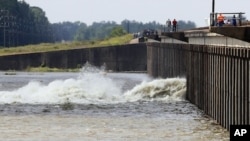Water is flowing out of one gate at the Morganza spillway north of Louisiana's capital of Baton Rouge in an effort to save that city and New Orleans from the flood waters of the Mississippi River. The urban areas may come through unscathed, but many people in the path of the diverted flood water will not be so lucky.
The man who made the decision to open the Morganza spillway for the first time in 38 years, US Army Corps of Engineers Major General Michael Walsh, says he hopes this action will prevent a major disaster as the cresting flood waters move closer to Louisiana's urban zones, shipping lanes and oil and gas infrastructure. “The crest right now is still up in Arkansas, it has not yet come down here. So this is certainly going to be a marathon and not a sprint as we go through this tremendous amount, huge amount of water as it comes down," he said.
Floods caused by Hurricane Katrina in 2005 damaged large sections of New Orleans and forced tens of thousands of people to leave the city and it has yet to fully recover. Any flooding at this time would represent a major setback for the city. High water on the lower Mississippi could also disrupt oil and gas operations in the area and shut down shipping activity at the port of New Orleans, the sixth largest port in the United States.
Only one of the Morganza's 125 floodgates was opened Saturday, with the expectation that one or two more will be opened on Sunday. Colonel Ed Fleming, also with the Corps of Engineers, told reporters it is necessary to work slowly and carefully in opening the floodgates. “There is a slow opening for a lot of reasons; one is that the water comes out of here pretty quickly and you do not want to scour the backside of this structure. From an environmental perspective, obviously there are lots of bear and other wildlife and we want to make sure they have the opportunity to get to higher ground," he said.
This is the first time the Morganza spillway has been opened for flood control since 1973. It is part of a flood control system built in the decades following the disastrous flood of 1927 that claimed around 1,000 lives.
About 25,000 people and some 11,000 structures lie in the path of the water that is being released from the spillway over the coming week or so. Many residents of the area have already taken what possessions they could carry and have moved out. Many farmers in the area are losing crops in the fields to the diverted flood water. In Morgan City, an oil industry and fishing port near the Gulf of Mexico, officials have fortified levees to protect buildings and residences.
Even with the release of water from the Morganza spillway, flood waters on the Mississippi river could still cause some disruptions to normal energy and shipping operations in the days ahead. Exxon Mobil has already closed some of its pipeline operations in the region as a precaution and a number of refineries may also have to shutdown temporarily.
The flooding was caused by snow melt and heavy rains in northern states that has been carried south by the Mississippi and its tributaries. Upstream from Louisiana, flooding from the Mississippi has taken a hard toll on people and farms in low-lying areas around Memphis, Tennessee and Vicksburg, Mississippi.
President Barack Obama plans to visit some of the flooded areas on Monday.











